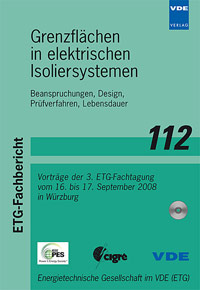Interfacial aging phenomena of superhydrophobic composite insulating surfaces under electrical and non-electrical stresses
Conference: Grenzflächen in elektrischen Isoliersystemen - 3. ETG-Fachtagung
09/16/2008 - 09/17/2008 at Würzburg, Germany
Proceedings: Grenzflächen in elektrischen Isoliersystemen
Pages: 4Language: englishTyp: PDF
Personal VDE Members are entitled to a 10% discount on this title
Authors:
Wu, Junliang; Schnettler, Armin (Institute for High Voltage Technology, RWTH Aachen, Germany)
Abstract:
This paper reports a study of interfacial phenomena and their influence on the working performances of a newly developed composite insulation system - superhydrophobic insulating surface. Experimental investigations of the material degradation are performed by using a variety of accelerated electrical and non-electrical aging tests. In this work, the long term stability of polymeric superhydrophobic insulating surfaces, which are created by coating with special organic nanoparticles, is examined under different ambient conditions. Compared to the result of a mechanical stress test with water droplets, the modification layers, consisting of the nanoparticles, demonstrate a clear decrease of the life spans, if the external interfaces of surface-modified epoxy resin are exposed to corona discharges caused by a non-uniform electric field. Therefore, it is believed that this kind of overstress accounts for a sharp acceleration of material aging and thus can result in an early failure of insulating systems in operation. On the other hand, in a humidity test, static contact angle measurements of specimens after surface treatments provide an insight into the long-term performance of this composite insulating system under wet conditions. It is shown that the hydrophobicity class of surface-modified specimens is not significantly affected by the moisture alone. Finally, the aging performance of the superhydrophobic surfaces is systematically assessed, allowing for the external interfacial phenomena under mechanical, electrical (corona) stresses and humidity, respectively. The findings from this work will be helpful to an optimization of the composite insulating system.


